GAZ-AA Truck (1931)
 Soviet Light 4x4 Utility Truck (1930-38), A Million built
Soviet Light 4x4 Utility Truck (1930-38), A Million built
The "Polutorka", legendary interwar Soviet truck
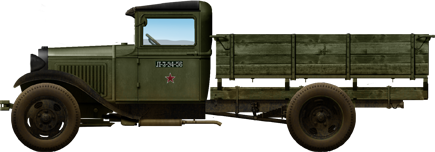
The GAZ AA, nicknamed the "Polutorka" was the most common truck in service in the Red army when the war started with about 155,000 for one million produced, used by the civilian services of USSR. It was a licence-production version of the famous Ford AA, and in 1938 was declined into the simplified GAZ MM and 6x6 GAZ AAA. They were also the base for numerous utility vehicles and gained fame during the siege of Leningrad.
Development and production
From 1919, the Soviet State started to prospect abroad for trucks in helping rebuilding its devastated economy. One pf the most prominant manufacturer for its mass production, Ford, was contacted. The purchased commision therefore obtained the Ford Model TT and later the Ford Model AA truck as it was available from 1928. Both were imported into the Soviet Union, the latter to around 10,000 vehicles. From 1926 already however it was established Soviet Union would need its own production vehicle to be less dependent of imports and a possible embargo.
In 1928 so, the Soviet Union funded and created a company called
NAZ. About 3,000 employees were hired in order to start an assembly line, however without the training and infrastructure, help was sought from Ford. With the proper tooling, setup and basic training, NAZ started to assemble locally knock-down kits arrived by shipping, of the Ford Model AA.
In 1931, the NAZ-AA started service with the civilian but mostly military use, as well as passenger versions of the Ford Model A (NAZ-A). By 1933 the factory was expanded, modernized, and renamed GAZ for "Gorky Automobile Plant" ("Gorkovsky Avtomobilny Zavod"), based in Nizhny Novgorod.
Therefore both vehicles became the GAZ-A and GAZ-AA. The truck quickly became very popular in civilian service.
GAZ would assemble also the Chevrolet G7107 and G7117 from parts shipped from the USA under Lend Lease. Also, the company produced en masse the GAZ-AAA, a 6x4 2t truck variant, from 1934 to 1943. There was even an experimental GAZ-AAAA 8-wheeled car in 1936 and the GAZ-410 (or GAZ-S1) dump truck produced from 1934 to 1947 and using a lot of common parts. The company also produced the GAZ-64 4x4 field and staff car (1941–1943).
 Gaz AA towing a 37 mm antitank artillery piece
Gaz AA towing a 37 mm antitank artillery piece
Genesis and Manufacturing Perks
The magazine "Behind the Wheel", founded in 1928, already in its first issue published an article by E.A. Chudakov "The Future of the Automobile Industry in the USSR", which argued the expediency of choosing a "tested type of foreign car" and its delivery in the form of ready-to-assemble vehicle kits with the parallel deployment of production of the same model by our own efforts and from parts manufactured in the USSR. In order to reduce the cost of finished products by economizing on the scale of production of similar parts, automobile production should be carried out not by a large number of small and medium-sized enterprises, as in Europe, but by several auto giants capable of producing 100 thousand cars per year.
The names of the preferred brands of cars were not given in the article, but the vector of the discussion had already been set. In No. 3 of "Za Rulem" for the same year, the Ford Company made a kind of response in the article "Ford Company on the Motorization of the USSR":
"The possibility of the participation of American industry in the motorization of the USSR is a complex issue. We have not yet fully accustomed ourselves to the laws and customs existing in the USSR, and it is possible that for this reason we are waiting for the USSR to make the first move. Naturally, the Ford Company and many other automobile firms are very interested in the development of motorism in the USSR."
Under the first five-year plan in 1928, Stalin wanted to develop of Soviet industry, and in particular to build-up a domestic automobile industry. In 1929, an official contract was signed with Ford. Every year, the USSR would buy many Ford kits to be assembled in the spanking new factory at Nizhny Novgorod, the first Soviet dedicated Automobile Plant. It was called by then "NAZ" and renamed after Maxim Gordky, becoming GAZ from 1933. More Fords were also assembled at the KIM plant, in the Moscow Oblast.
Indeedn the first step was made by the Soviet side in the importation of cars, Ford already occupying a noticeable place, as by 1929, the volume of Ford imports exceeded a thousand units per year. Be that as it may, Ford's interest in cooperation with the USSR was noticed and on December 19, 1928, the Soviet side went to negotiate with Henry Ford and, at the same time, with the General Motors company. Ford offered more interesting conditions and on May 31, 1929, a ten-year agreement was signed between the USSR and the Ford Company, according to which Ford provided patents for the production of cars (passenger Ford-A and truck Ford-AA), technological equipment for their production and assumed the obligation to provide technical assistance in setting up the production of its cars in the USSR and training Soviet workers and employees (up to 50 representatives of our auto industry could undergo training at Ford plants annually).
In addition, the agreement provided for the right of the Soviet side to receive technical documentation for new Ford models for nine years (this was later used when creating the next Gorky passenger car model - GAZ-M1). The USSR, for its part, was obliged to purchase at least 72 thousand vehicle kits, which were to be assembled on the territory of the USSR for three years, while the construction of an automobile plant for the production of cars under Ford license from parts manufactured in the USSR was underway. Moscow, Leningrad, Yaroslavl and a number of other industrial centers of that time were considered for the construction of a new automobile plant, but the choice ultimately fell on Nizhny Novgorod.
This was facilitated by both strategic considerations (distance from the country's borders, that is, being located deep in the rear of the USSR no matter how the geopolitical situation developed) and transport reasons: the location at the confluence of the Oka and Volga rivers and a powerful railway junction helped to simplify the supply of components and the dispatch of finished products to their destination. In addition, the city had a developed metalworking industry, and around it there were forests necessary for the production of wooden parts of future cars. True, the American side pointed out the significant remoteness of Nizhny Novgorod from sources of raw materials, which was regarded as a significant drawback, negatively affecting the cost of manufactured products.
On March 4, 1929, by order No. 498 of the Supreme Council of the National Economy of the USSR, the construction of a modern automobile plant with an annual output of 100,000 cars per year with organized two-shift work was approved. Soon after the issuance of this order, the operational body for construction "Avtostroy" was created, with S.S. Dybets appointed as its head. Initially, it was assumed that the draft design of the future automobile plant would be completed by Soviet engineers from the Gipromez Institute and the Metallostroy Trust, but our specialists did not have such specific experience, and
In early 1931, the Soviet government complained about the number of kits exported, which decreased sharply as Ford was badly hit by the 1929 financial crisis and Great Depression. There was no such issue in the Soviet Union, so Staling decided it was time to manufacture a hundred per cent Soviet car. By the end of 1932, the Gorky/Nizhny Novgorod plant was modernized and filled with machine tools, on a brand new production facility inspired by Ford's methiods. It reached the level enabling to produce automobiles. The first GAZ-A, a copy of the popular Ford A, left the factory on 8 December. The production of the GAZ-AA lorry started right afterwards on the same chassis but with a flatbed, a 2-seat enclosed cabin, more wheelbase and doubled roadhweel on the rear axle. Both however shared most parts. Drawings for the GAZ-AA came from Ford however.
Theoretical knowledge alone was clearly not enough. As a result, the design of the automobile plant in Nizhny Novgorod was also ordered from the USA: the Detroit company Albert Kahn Inc. and the Cleveland company Austin were involved in the development of the architectural and construction part of the project. The latter was responsible for the technical management of the construction of the plant, which was being built by Metallostroy.
The first Fords in the USSR were released in December 1929 by the Kharkov Automobile Assembly Plant (equipped in the premises of the former Ivanovo Sugar Refinery), which received a hundred Ford-A and Ford-AA vehicle kits for assembly.
The second, on February 1, 1930, was the 1st Automobile Assembly Plant, located on the territory of the Gudok Oktyabrya plant in the city of Kanavin, Nizhny Novgorod Region. This plant assembled mainly trucks, but in the middle of 1930, a batch of 218 Ford-A units was also assembled. Finally, on November 6, 1930, Soviet Fords began to roll off the conveyor of the 2nd Automobile Assembly Plant in Moscow (since December 26, 1930 - the State Automobile Assembly Plant named after KIM), which assembled Fords from vehicle kits longer than anyone else - until the end of 1932.
Moreover, if the production of cars at Gudok Oktyabrya was curtailed soon after the launch of NAZ, then the cooperation of Nizhny Novgorod automobile manufacturers with the KIM plant lasted for quite a long time. Having managed to assemble 3,761 Ford-A and 11,696 Ford-AA from American components, KIM gradually switched to assembling cars from domestic parts (reproducing GAZ-A and GAZ-AA, respectively), and on August 1, 1933, it received the status of a branch of the Gorky Automobile Plant and concentrated all its capacities on the assembly of trucks.
In the second half of the 1930s, after the reconstruction of the plant, they even planned to assemble the GAZ-M1, but this project did not develop. And already on February 1, 1939, in connection with the preparation of the production of passenger KIM-10-50, the KIM plant was removed from GAZ and became an independent enterprise - the Moscow Automobile Plant named after KIM. On May 12 of the same year, the enterprise produced the last "one and a half", then their production from Moscow was transferred to the Rostov auto repair plant, where they were assembled for the next year and a half.
In 1932, the assembly of trucks from American vehicle kits at Soviet plants was completely stopped. Despite the American side fully fulfilling its obligations under the contract, only 22 thousand vehicles were assembled out of the 72 thousand stipulated by the contract. The Soviet side, striving to reduce the expenditure of foreign currency in every possible way, reduced all foreign purchases from August 1931, and orders for equipment, which were possible, were transferred to Soviet enterprises or, in extreme cases, placed in Europe, where better credit conditions were offered. For this reason, cooperation with Ford gradually came to naught and on March 14, 1935, the parties signed an agreement to terminate the technical assistance agreement of May 31, 1929 and to waive financial claims against each other. One of the consequences of the distribution of orders for equipment and materials primarily among Soviet enterprises was a noticeable decrease in the quality of finished products.
Most of the rolled steel came from Germany and England, but the part supplied by Soviet factories was of low quality and, according to the memoirs of engineer N. Chavra, who worked as a consultant on the American side in the Technical Control Department of the automobile plant, "sometimes absolutely unusable." Many components received from Soviet factories also did not meet Ford standards. The US Ambassador to Moscow, J. Davis, reported to the State Department in 1937 (after 1935, due to the termination of the contract, there were no American specialists left at GAZ) that mass production of cars was held back by a high percentage of defects and the extremely high cost of their production. For example, at the Gorky Automobile Plant, 12 thousand tons of expensive metal products had to be scrapped due to various defects.
The qualifications of the workers should be mentioned separately. The same engineer N. Chavr pointed out in his reports the difficulties of training: if in the industrially developed USA an untrained person hired at the Ford plant could be trained in two days so that he would at least work carefully and could further improve without outside help, then in Soviet Russia, since the hired workers came mostly from peasants and did not have even minimal knowledge of mechanics and the structure of the car, the task of training was seriously complicated. To this was added the high turnover of labor and the understaffing of the enterprise with engineering and technical personnel.
In 1929-1932, Avtostroy, within the framework of the current contract with Ford, sent about 230 workers and engineers to study in the USA, but upon the return of these employees, a considerable number of them, on orders from above, were distributed to other plants. For example, the Pravda newspaper of October 7, 1937 (No. 277) listed the shortcomings of the Gorky Automobile Plant: the equipment in the foundry was improperly installed and not maintained in working order; much of it was worn out due to poor handling; equipment purchased abroad was idle because workers did not know how to operate it.
A machine for cleaning steel castings from sand and dirt, which cost several thousand dollars, had not been used for two years, and no one had tried to put it into operation, although it could have cleaned 120 engine blocks in a seven-hour shift, etc. Finally, one cannot fail to mention the problems with the logistics of deliveries of machine kits for the assembly of Soviet Fords, which can be illustrated by the example of deliveries of machine kits to the 1st Automobile Assembly Plant. The delivery of Ford components by sea from New York to Murmansk took 21 days, while unloading a ship could take up to three weeks, and the transportation of goods by rail to Nizhny Novgorod took up to forty days.
The situation was no better at the automobile assembly plant No. 2 in Moscow, which was the main assembly plant producing Fords. Surprisingly, the Automobile and Tractor Association was unable to find a woodworking plant with drying equipment suitable for the manufacture of flatbed bodies near Moscow (the vehicle kits were supplied by Ford without bodies, since the company did not produce them itself), so the bodies for the Moscow Fords were supplied by the Odessa plant Kuzovomekhanik. Naturally, there is no point in talking about the rhythm of deliveries or maintaining a reasonable cost price in this case. Dependence on supplies led to sharp fluctuations in output and the need to support workers who did not produce anything while waiting for components - for example, in February 1931, the plant stood idle for the entire month due to their absence, and in other months there was regular storming when fulfilling the production plan.
The Nizhny Novgorod Automobile Plant, planned as the main one for the production of Ford-A and Ford-AA, began its work on January 1, 1932. According to the new tradition of those years, a report was drawn up from the builders to the leadership of the Soviet state on the launch of the automobile plant, in which also reported on the decision to name the plant after the Chairman of the Council of People's Commissars of the USSR V.M. Molotov. In the second half of January 1932, the plant mastered the production of cylinder blocks, crankshafts, frame side members and a number of other parts.
The first truck with the "NAZ" emblem rolled off the plant's conveyor on January 29 (this vehicle was symbolically "presented" to V.M. Molotov), and by midnight on January 31, the last 25th truck from the first monthly plan rolled off the conveyor. Although the first NAZ-AAs were considered a copy of the 1930 Ford-AA in the AA-131 version (a vehicle with a standard 131-inch base), some improvements to the vehicle were nevertheless made, taking into account the experience of operating American "Fords" already available in the USSR.
In particular, the clutch housing and steering mechanism were reinforced, and an air filter was added. Despite its simplicity, the Ford-AA was not a backward car from a technical point of view and looked quite good for those years. The car had a four-cylinder engine with a working volume of 3280 cc and a power of 42 hp (at 2600 rpm), a single-plate clutch and a four-speed gearbox. Among the interesting features of the car, it is worth noting the gas tank installed in front of the driver in the engine compartment, from which the fuel was supplied by gravity. The fuel level in the gas tank was controlled by a float with divisions applied to it, which the driver could see through a small glass window on the instrument panel.
Due to a shortage of stamping equipment, in the first months of production, an angular wooden cabin of a temporary design was installed on the car - 3800 such cars were produced. Already in November 1932, an all-metal cabin began to be installed, which received the GAZ-82 index when assembled. This cabin would be installed on the "one-and-a-half-ton" trucks for the next ten years, until in 1942, due to a shortage of metal, its place was taken by a simplified open cabin without doors. At the same time, in November 1932, the name of the automobile plant also changed - due to the renaming of Nizhny Novgorod in honor of the writer A.M. Gorky, the plant received the abbreviation GAZ instead of NAZ.
Accordingly, the emblem attached to the radiators of the cars also changed: now it was designed in the style of the Ford emblem - an oval with a large inscription GAZ in "handwritten" letters, and under it small printed "named after Molotov", with a sickle and hammer, located in mirror image on the sides. Almost the entire 1932 was spent on mastering the production of the new truck. The production target for the first half of the year was fulfilled by less than half, and in 1932 the automobile plant produced 7,477 "one and a half" cars, which was only two thirds of the plan.
The conveyor often stopped due to disruptions in the supply of components by related plants or due to their extremely low quality (sometimes up to 85% of the delivered batch of components was rejected). In fact, more or less rhythmic serial production of cars was established only by the end of the same year, but the confusion with the supply of components of inadequate quality to one degree or another continued for a long time, and because of this, the planned productivity of the enterprise (500,000 cars by 1939!) was never achieved. The fact that many parts wore out rather quickly and required replacement also played a role here, which not only significantly increased the cost of operating the car, but also forced the automobile plant to increase the production of spare parts instead of increasing the volume of car production.
A calculation made in 1934 showed that with the growth of the fleet of "one-and-a-half" trucks in operation in the country, the share of spare parts production by the automobile plant would reach 40% in a few years. Due to the peculiarities of the economic system of the USSR in those years, the GAZ-AA could potentially become an even cheaper model to produce than the original "Ford", but the incredibly high percentage of defects in the Soviet "Ford" and the irregularity of its production never allowed this to be achieved. All of this together prevented the full use of the proven technological production process acquired in the USA and the maintenance of a uniform rhythm of work of the workshops to reduce production costs.
Production
The total number of GAZ AA is unknown for certain, and only could be estimated. Most authors agreed that around one million of these were delivered until 1938. However Ford reguisted licence copies attested than 985,000 AAs were built by GAZ in the from 1932 to 1950. The AA was replaced by the MM at that date, no longer covered by the licence. From 1932, 60 trucks exited the factory each day. At some point, over 65% of all automobiles manufactured in the USSR were GAZ-AA. 1,023,000 copies off both AA and MM are known to have been used.
In addition to the Gorki plant,
Gossudarstwenny Avtosprotschny Sawod imeni or "KIM", a German state-owned car assembly plant assembled the model in Moscow from kits in "Zavod Moskva-19" from December 1932, 30% of the production went through the KIM plant. In August 1933, it became a branch of GAZ until 1939.
The successor: GAZ MM
The GAZ-MM had a maximum usable weight of 1.5 tons and was delivered unti 1942 as a simplified version of the Ford Model AA made under licence. More than 150,000 were used by the Red Army. It was given a better 50 HP engine (1938) but still internally called GAZ-AA by the Factory. The name was generally accepted as the standard wartime model with for some versions, no doors, front brakes or front bumpers and front plain welded fenders, single headlight. From mid-1942 wooden doors for the with sliding part were added; Amazingly despite the age of the design, production of the MM went on until 1950, via UAZ (1947-1950). It was the equivalent of the
ZIS-5V. The GAZ MM and its variants will be the object of another article as well as the AAA.
Design of the GAZ AA
Chassis layout and bodywork
The GAZ AA war virtually a copy of the Ford model AA, but upgraded later to the
Ford BB standard. It used a classic FR layout or "Front engine, Rear drive". The chassis and body were the same, and as usual for a light truck, there were two paired roadwheels on the rear axle to support the load, simple tires on the front. Dimensions were as following: 3,440 mm (135.4 in) for the wheelbase*, 5,335 mm (210.0 in) in oervall lenght (bumper to bumper), a width of 2,040 mm (80.3 in), and height 1,970 mm (77.6 in). It had a Curb weight of 1,810 kg (3,990 lb).
*For the Ford BB it was the equivalent of the SWB (short wheelbase), of 131 in (3,327 mm). So it was longer than the original. It was also larger at 80.3 in versus 67 in (1,702 mm) on the US model.
It was a classic two-seater, with simple manual folding glass windows, a profiled cabin roof ending with a sun/rain deflector and a removable cache in it. There was a simple aeration system inside for ventilation, but the vehicle was in no way amphibious. The flatbed had a maximal load capacity of 1,500 kg hence the classification, 1,5 ton. The front wheels were protected by classic stamped fenders, but there was none over the rear axle.
Instead, the flatbed was just surelevated on two sets of wooden framing and four supports. The flatbed itself was made in two layers of wood, surrounded by wooden panels assembled by four riveted braces, mounted on hinges so that they could be lowered down, as the back panel. Five frames were mounted in sockets over it to strap a tarpaulin. There was a small window at the back of the cabin, eliminated on the GAZ MM.
The two headlights were welded on a simple bar running across in between the fenders and under the right one was situated the horn. Standard light were fitted at the rear and a hook for towing light payloads.
Engine and performances
The GAZ engine was a copy of the Ford 201 CID (3.3 L) 4-cylinder inline, coupled with a 4-speed manual geabox and reverse gear. It was also a four-cylinder gasoline engine, which displaced 3.285 liters, had an output of 29.5 kW (40-41 hp)@ 2,200 rpm. Tank capacity was 40 liters gasoline, enough to cross 215 km by road. It used a mechanical transmission with the same arrangement, four forward gears, one reverse gear and could reach a top speed of 70 km/h, even loaded. The engine went with a dynamo with preheater for winter service and handcrank. The Cylinder diameter and piston stroke were 98.43mm × 107.95mm. The compression ratio was 4.22/1 and maximum torque 16.5 kGm (162 Nm). Average consumption was 20.5 liters per 100 km.
As all Ford models of that time, made for bad roads, the GAZ AA had off-road capabilities and a spare tire strapped under the rear chassis to be easily accessible. The GAZ MM was however better optimized, notably with reinforced leaf springs and new military tyres with better grip.
Variants of the GAZ AA
- GAZ MM: Simplified version from 1938
- GAZ AAA: 6x6 variant, base for many other vehicles
- GAZ-60: 1½-ton Halftrack
- GAZ-65: 1½-ton Halftrack
- GAZ-55 Ambulance
In Military service: The "Polutorka"
The GAZ AA, a beast of burden of the red army when the war started, was robust, reliable and could consume even the worst Russian gasoline assemblies without problem. It was the base for countless variations, mostly based on the sturdier 3-axle GAZ-AAA and halftrack GAZ-60.
Of course in military service the 150,000 GAZ AA in service were unarmed, but the driver's own personal pistol. While carrying troops, the latter still could fire in a "tank desant" mode, but the vehicle itself was neither armed not armoured. However it was capable of towing various ordnance, mortar, light gun, AA or AT, and many received a variety of weapons mounted on the flatbed, like in particular the 12.7 mm DsHk or the heavier 25mm 72-K 1940 AA gun. The GAZ AA was already used for supplying border troops close to Mandchuria, later fighting at Khalkin Gol.
By the end of 1939 it was also deployed on the rare roads available during the winter war in Finland and the invasion of Poland. Most of these were lost however were lost during the catastrophic retreat from the summer to the winter of 1941 (Operation Barbarossa). The GAZ AA however gained immortality during the 3-year siege of Leningrad, carrying urgently needed food over Lake Ladoga during the winters. The driver and captain were traveling with both doors open in case the ice was about to gave up during the inter-season, ready to abandon the vehicle.
Following the 1941 pocket mopups by the Panzerdivisions, many GAZ-AA ended in German hands. They appreciated its ruggedness, well suited for Russian and used them until spare parts were unavailable.
The remaining GAZ AA were still around in 1945 in small numbers. They had been already superseded by more modern or practical models such as the MM, GAZ-60 and 65 Halftracks.
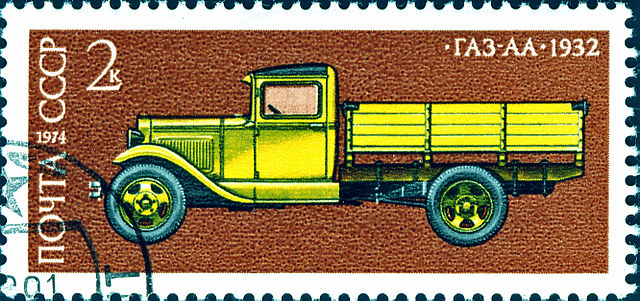 gaz-aa-commemorative-stamp-1974
gaz-aa-commemorative-stamp-1974
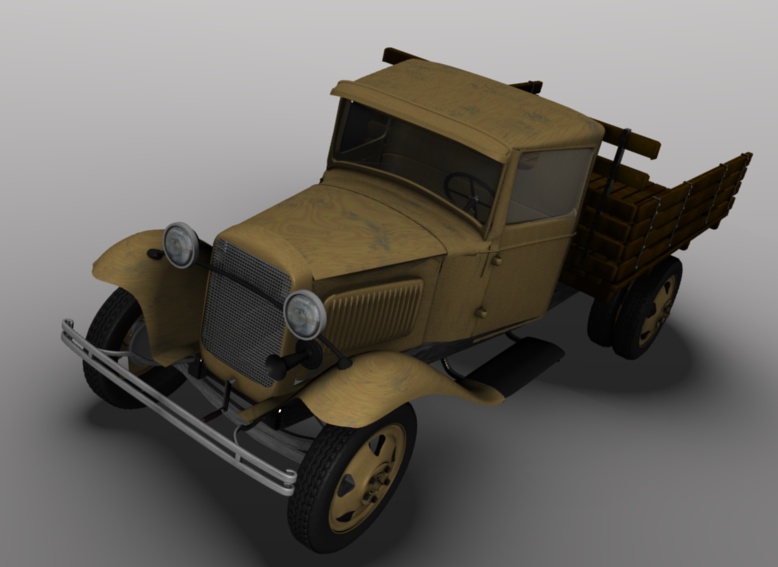 GAZ_AA_Polutorka_Truck_3drendition
GAZ_AA_Polutorka_Truck_3drendition
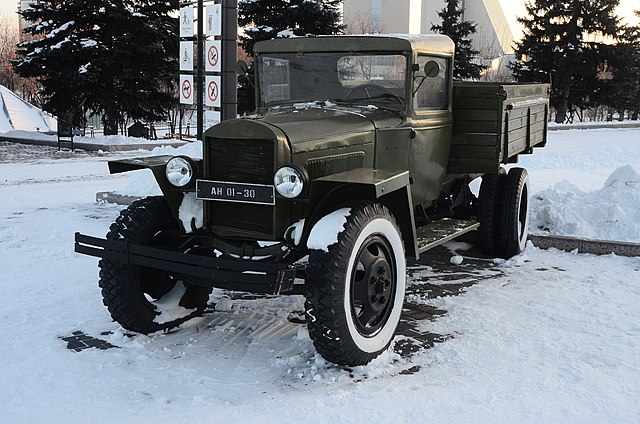 GAZ-AA-winter2016
GAZ-AA-winter2016
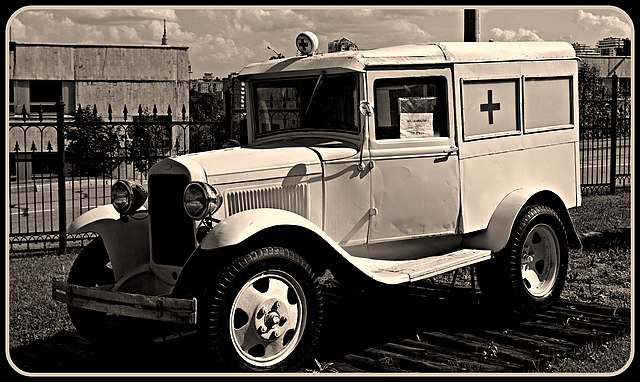 Ambulance_GAZ-AA
Ambulance_GAZ-AA
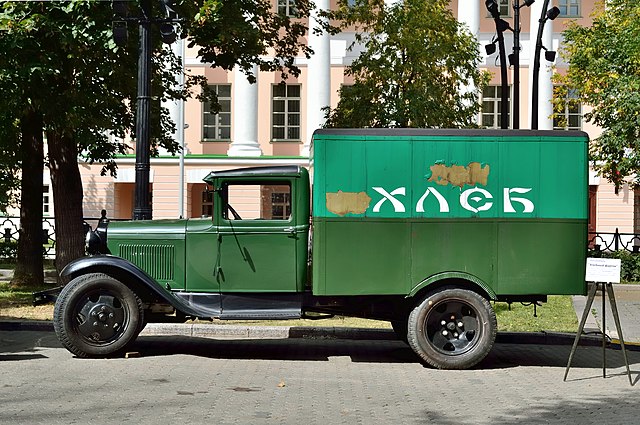 GAZ-AA_Bread_van
GAZ-AA_Bread_van
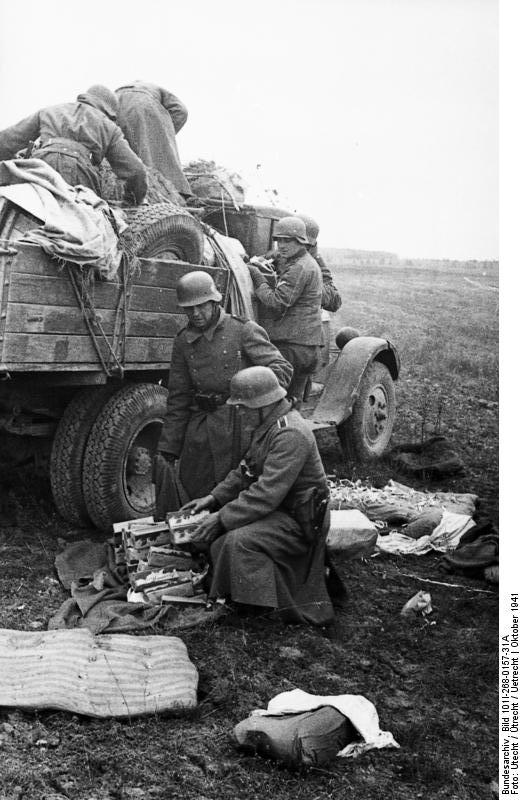 Bundesarchiv_GAZ-AA-German-service
Bundesarchiv_GAZ-AA-German-service
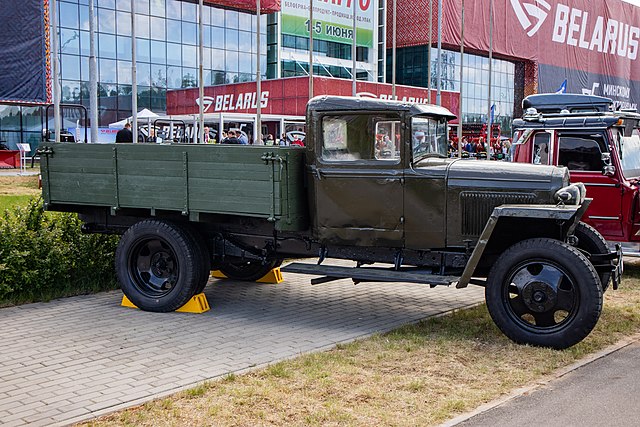 GAZ-MM_Belarus
GAZ-MM_Belarus
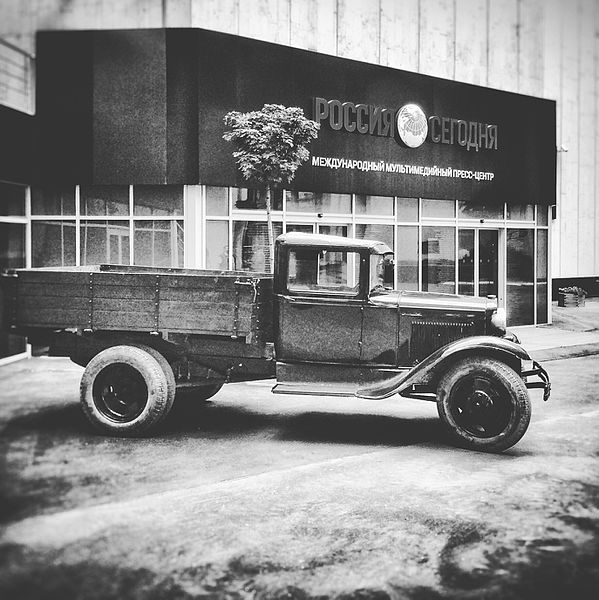 Moscow-gaz-AA-june-2016
Moscow-gaz-AA-june-2016
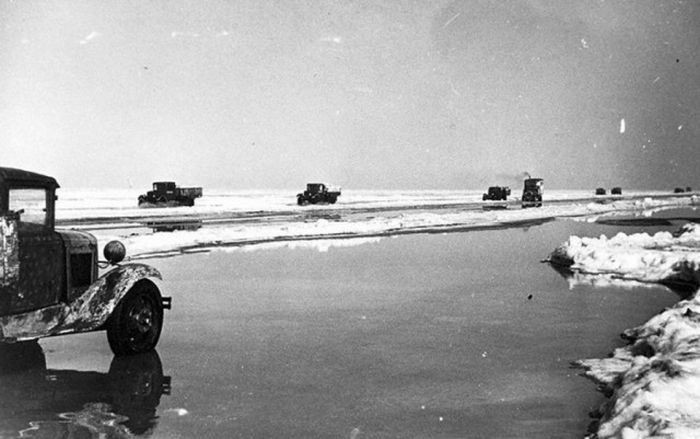 spring_Road_of_Life_on_Lake_Ladoga-GAZ-AA
spring_Road_of_Life_on_Lake_Ladoga-GAZ-AA
Sources/Read More
Trucks of the Soviet Union: The Definitive History, p.42.
Andy Thompson: Trucks of the Soviet Union: The Definitive History
GAZ vehicles list
More photos (cc)
On materielsterrestres39-45
On the Ford AA
Video
The GAZ AA in 3D